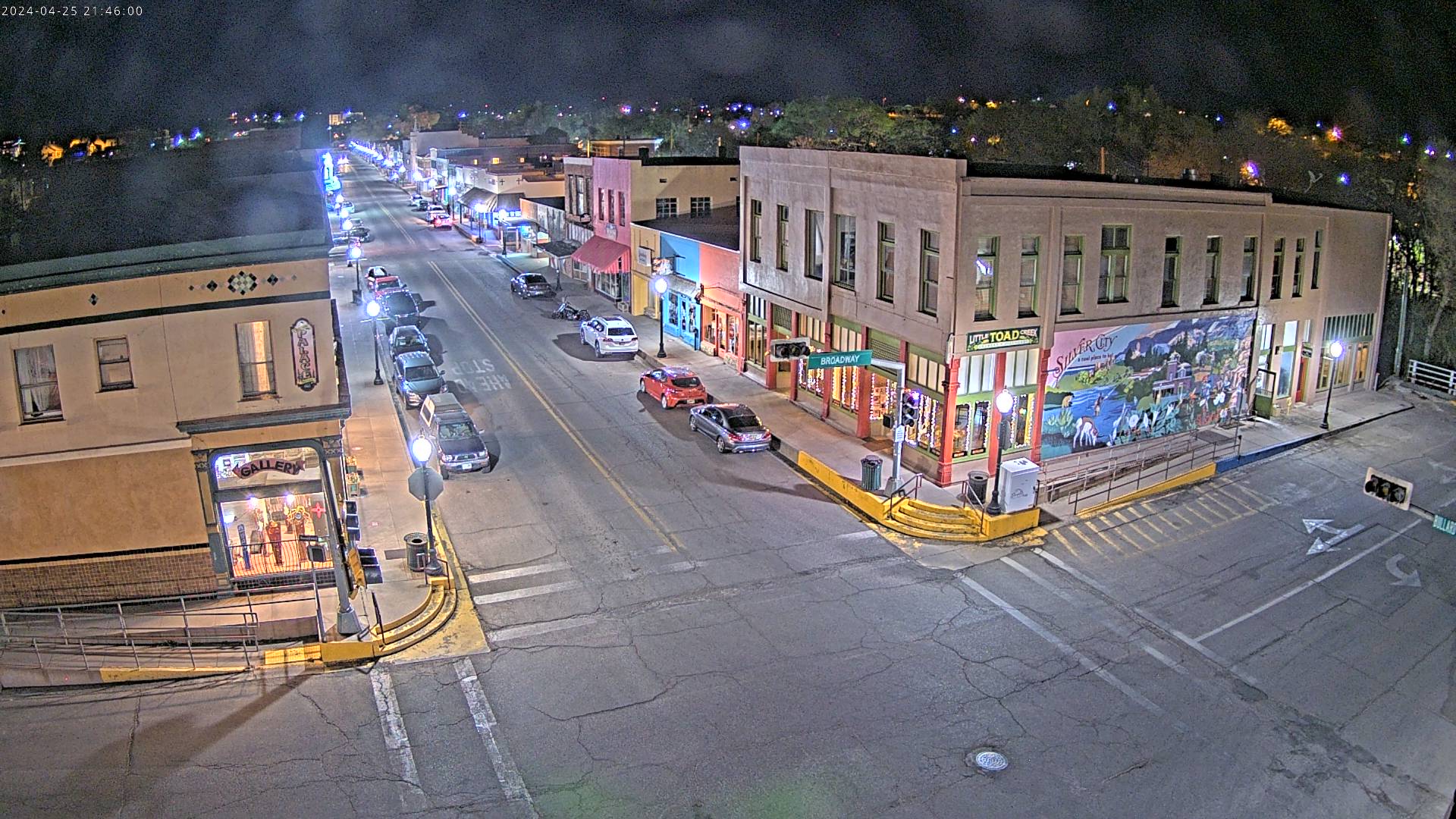-
Silver City
-
 The valley that is now the site of Silver City once served as an Apache campsite. With the arrival of the Spaniards, the area became known for its copper mining. After the American Civil War, a settlement developed and became known as la Ciénega de San Vicente (the Marsh of St. Vincent). With a wave of American prospectors, the pace of change increased, and Silver City was founded in the summer of 1870. The founding of the town occurred shortly after the discovery of silver ore deposits at Chloride Flat, on the hill just west of the farm of Captain John M. Bullard and his brother James. Following the silver strike, Captain Bullard laid out the streets of the Silver City, and a bustling tent city quickly sprang to life. Although the trajectory of Silver City's development was to be different from the hundreds of other mining boom towns established during the same period, Captain Bullard himself never lived to see even the beginnings of permanence, as he was killed in a confrontation with Apache raiders less than a year later, on February 23, 1871.
The valley that is now the site of Silver City once served as an Apache campsite. With the arrival of the Spaniards, the area became known for its copper mining. After the American Civil War, a settlement developed and became known as la Ciénega de San Vicente (the Marsh of St. Vincent). With a wave of American prospectors, the pace of change increased, and Silver City was founded in the summer of 1870. The founding of the town occurred shortly after the discovery of silver ore deposits at Chloride Flat, on the hill just west of the farm of Captain John M. Bullard and his brother James. Following the silver strike, Captain Bullard laid out the streets of the Silver City, and a bustling tent city quickly sprang to life. Although the trajectory of Silver City's development was to be different from the hundreds of other mining boom towns established during the same period, Captain Bullard himself never lived to see even the beginnings of permanence, as he was killed in a confrontation with Apache raiders less than a year later, on February 23, 1871.The town's violent crime rate was substantial during the 1870s; Grant County Sheriff Harvey Whitehill was elected in 1874, and gained a sizable reputation for his abilities at controlling trouble. In 1875, Whitehill became the first lawman to arrest Billy the Kid, known at the time as William Bonney. Whitehill arrested him twice, both times for theft in Silver City, and would later claim that Bonney was a likeable kid, whose stealing was a result more of necessity than criminality. His mother is buried in the town’s Memory Lane Cemetery.
In 1878, the town hired its first town marshal, "Dangerous Dan" Tucker, who had been working as a deputy for Whitehill since 1875. According to the book, Dangerous Dan Tucker, written by Bob Alexander, "After the McClaurey brothers and young Billy Clanton were gunned down near Tombstone's Fremont, the feud between the Earps and the "cowboys" and the competing newspaper journalists began in earnest. Common sense would recognize that if Wyatt Earp (or anyone else) was "inviting a confrontation" he could have had one at any time or place of his choosing. For his own reasoning, Wyatt Earp chose to flee rather than to fight or take his chances with due process by submitting to lawful arrest. To avoid this arrest, Earp and his entourage traveled to Silver City on horseback to eventually reach Colorado. One author concludes, that the bunch avoided a much quicker and more direct route through Deming because they feared arrest from Dan Tucker. Earp and Doc Holliday both avoided Silver City because of Dangerous Dan Tucker with a reputation of intimidating prowess. Dangerous Dan Tucker was not only the first appointed marshal, he was a fierce gunslinger and a reputable lawman."
Mrs. Lettie B. Morrill, in a talk given to the Daughters of the American Revolution chapter in Silver City on September 19, 1908, stated, "John Bullard was placed in the first grave dug in Silver City, having been killed while punishing the Indians for an attack upon the new town; the brothers were Prospectors about the country for many years. The last one left for the old home about 1885, saying, ‘It is only a matter of time until the Indians get me if I stay here.’" It was also known as the starting point for many expeditions hunting treasures such as the Lost Adams Diggings.
In 1893, New Mexico Normal School was established. It was later known as New Mexico Western State Teachers College. In 1963, it was renamed Western New Mexico University. Today, WNMU offers 8 graduate degrees, 41 baccalaureate degrees, and 18 associate degree and certificate programs. The WNMU athletic team is referred to as the Mustangs.
The town had originally been designed with the streets running north to south. The town was also built in the path of normal water runoff. Businesses sprang up, and people learned to deal with the inconveniences of the summer rain. Silver City was built with high sidewalks in the downtown area to accommodate high flood waters. Meanwhile, uncontrolled cattle grazing thinned down plant life on hills surrounding the town, as did deforestation. During the night of July 21, 1895, a heavy wall of water rushed through the downtown business district, leaving a trail of destruction. A ditch 55 feet (17 m) lower than the original street level was created in what was once known as Main Street. Businesses on Main Street began using their back doors on Bullard Street as main entrances and eventually, were permanently used as the new front entrances. To this day, the incorrect odd/even addressing conventions on the east side of Bullard Street are a reminder that the buildings were addressed on Main Street originally, not Bullard Street. Main Street now ends near the back of the Silver City Police Station, where the Big Ditch Park begins.
The Mimbres Mogollon Indians (A.D. 200–A.D. 1140/50) once lived in the area, along with other prehistoric groups, including the Salado. Mimbres archaeological sites are located throughout Silver City and surrounding communities on federal, state, municipal, and private property. Collecting of Mimbres pottery by landowners and others is documented as far back as the late 1870s. Collecting was something that occurred during a Sunday picnic in the late 19th and early 20th centuries. Some individuals maintained collections that can now be seen in the Smithsonian, and other museums, which sent individuals out to acquire collections in the nearby Mimbres Valley during the early 1900s. Others dug into the ancient sites and used the pottery they found for target practice—something that occurred into the 1930s according to oral histories. Collecting, and the looting of Mimbres Mogollon sites did not stop with archaeological research conducted on private lands during the 1920s, 1930s, and 1970s, nor with the passage of the New Mexico "Burial Law" in 1989. Sadly, unlawful looting continues to this day, and many prehistoric sites have been badly damaged or completely obliterated.
The Apaches occupied areas in the vicinity of Silver City beginning in the late 1500s to early 1600s based on archaeological evidence.
Today, Silver City is a bustling town with a diverse business community, a four-year university and several thriving healthcare facilities.
-
-
Upcoming Events
-


.jpg)
-w468-w234(1).jpg)




